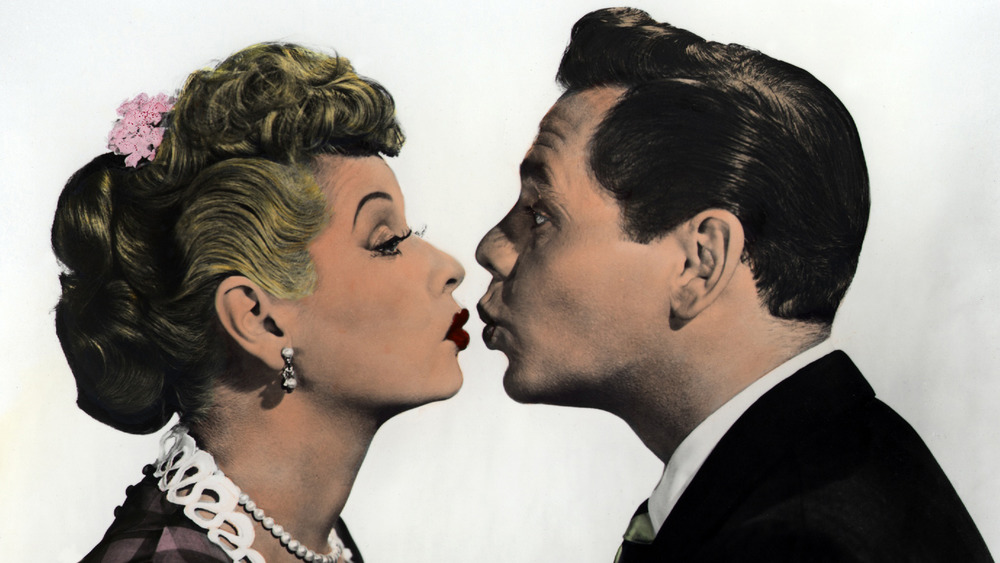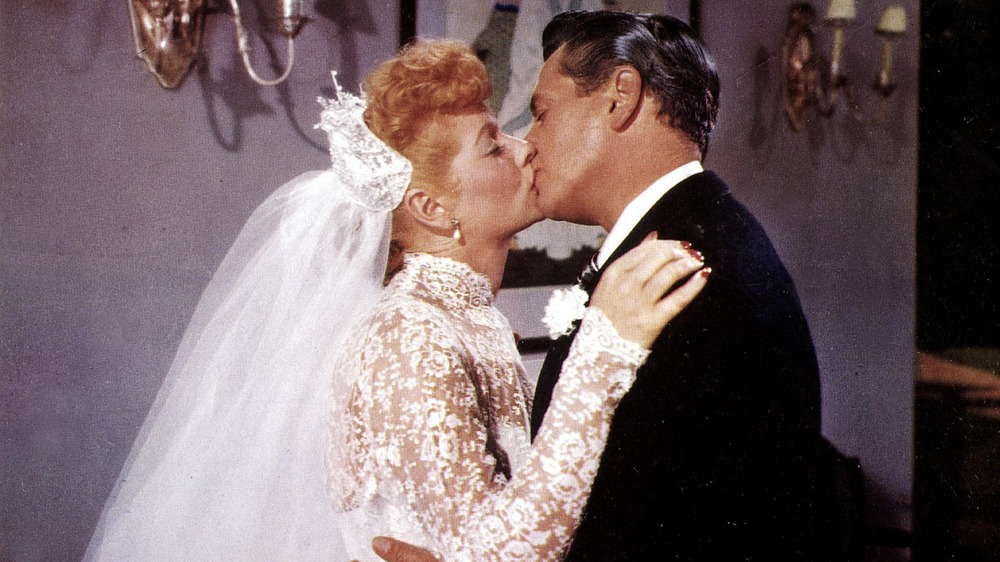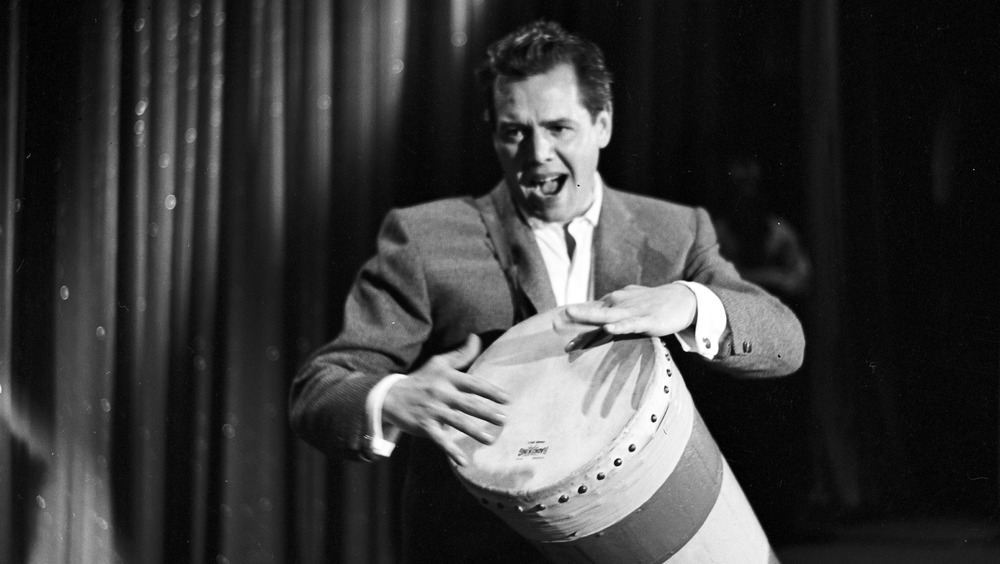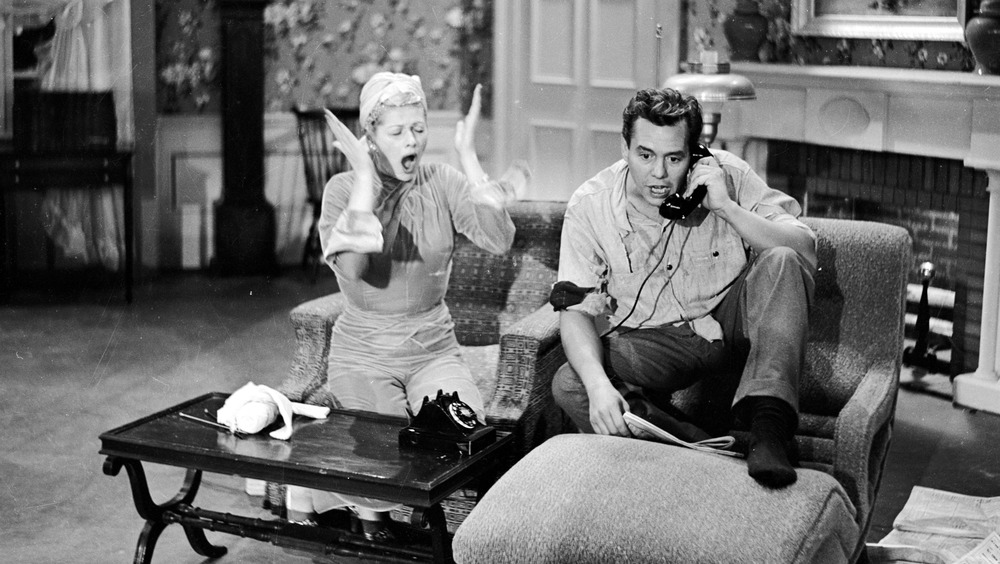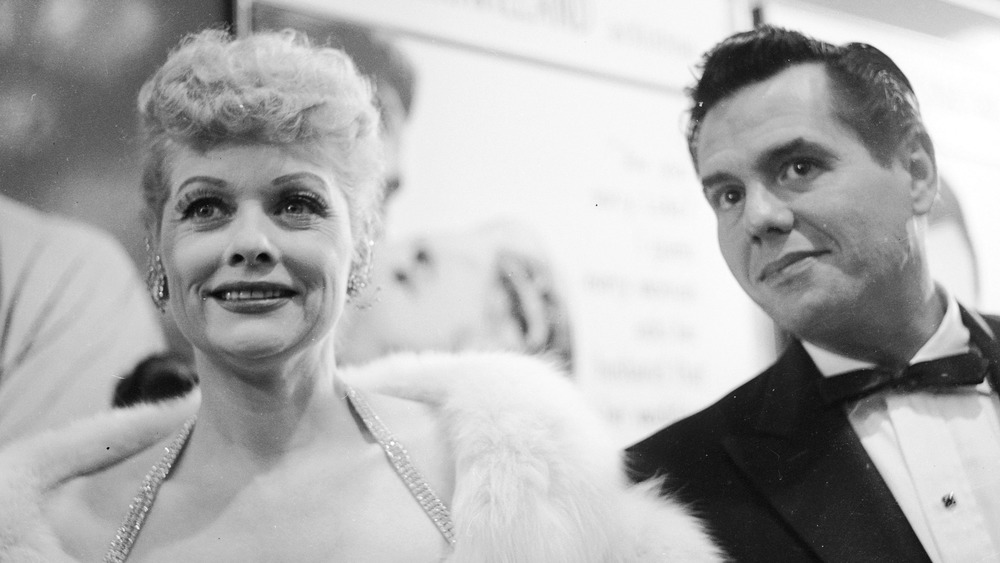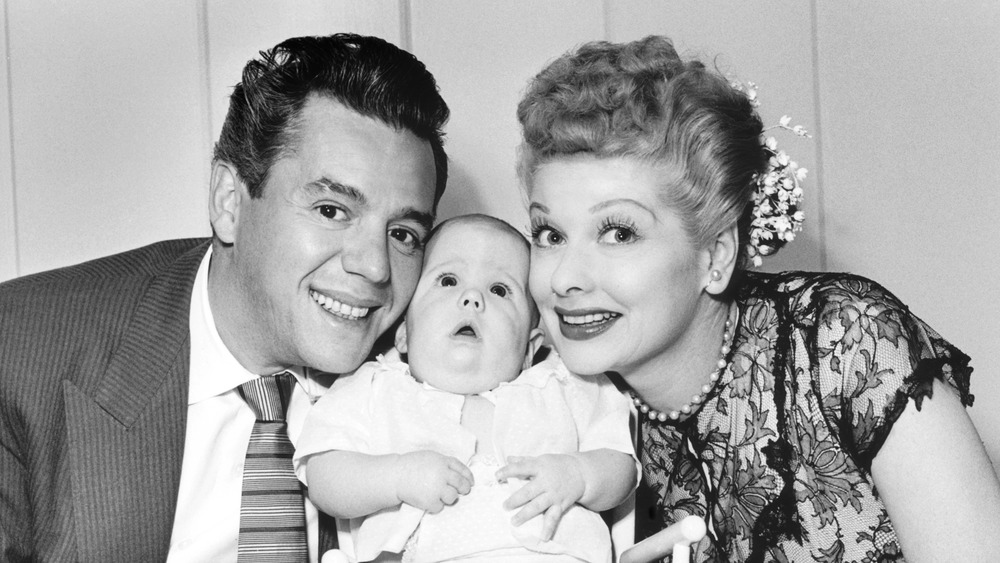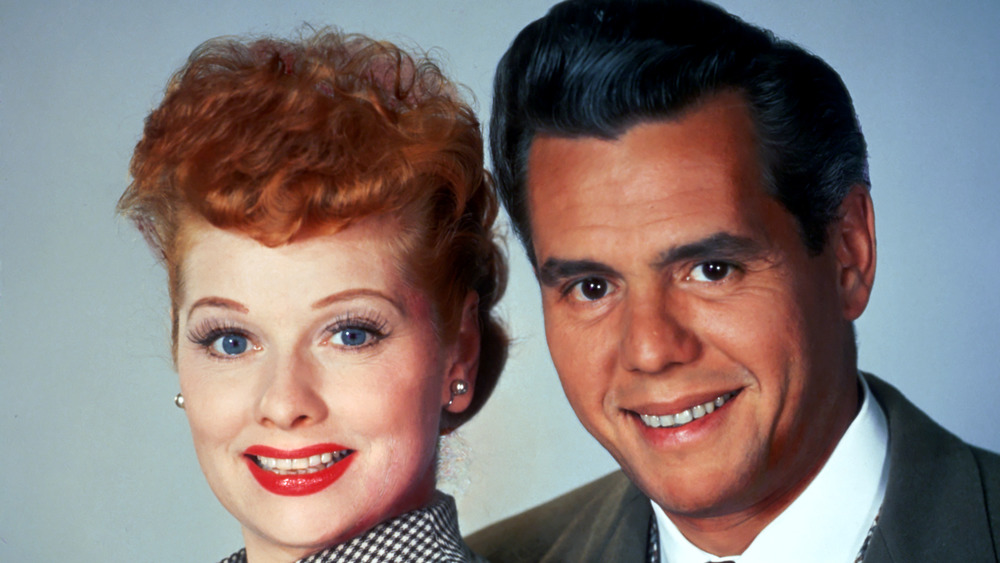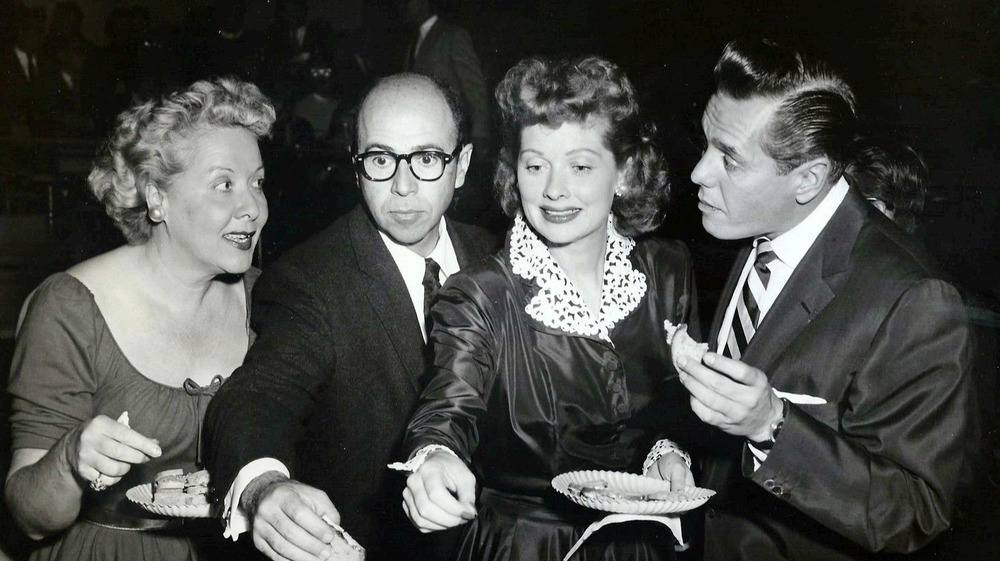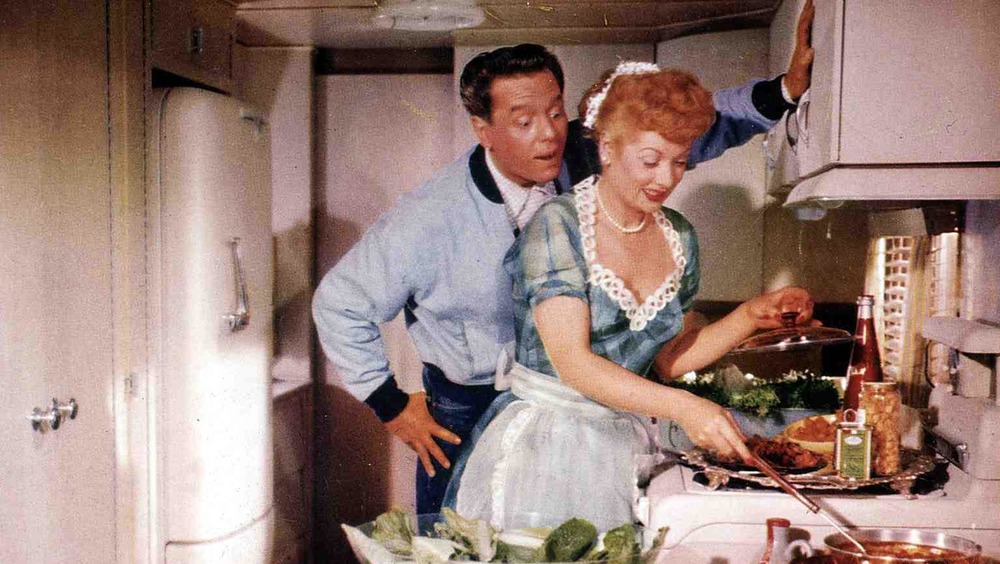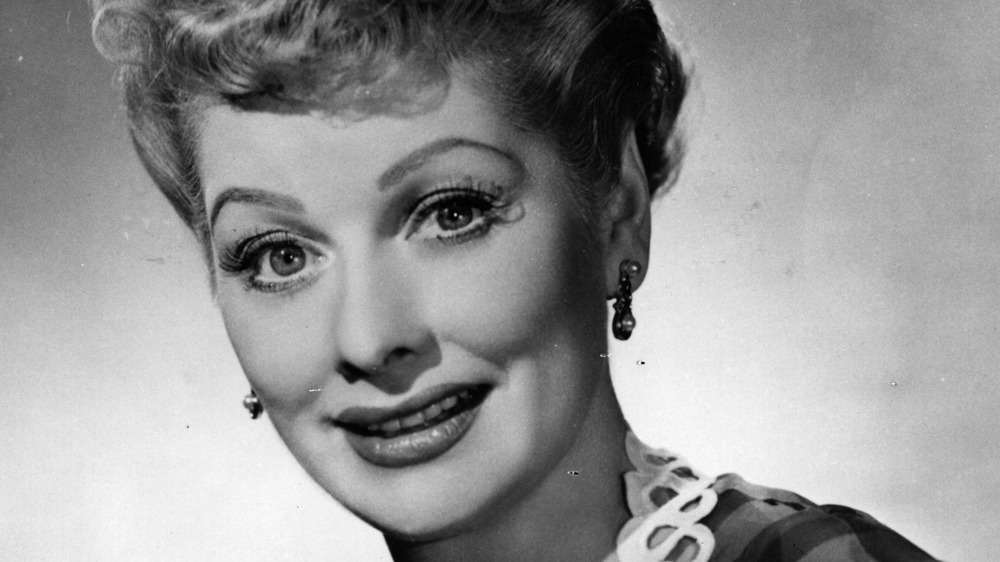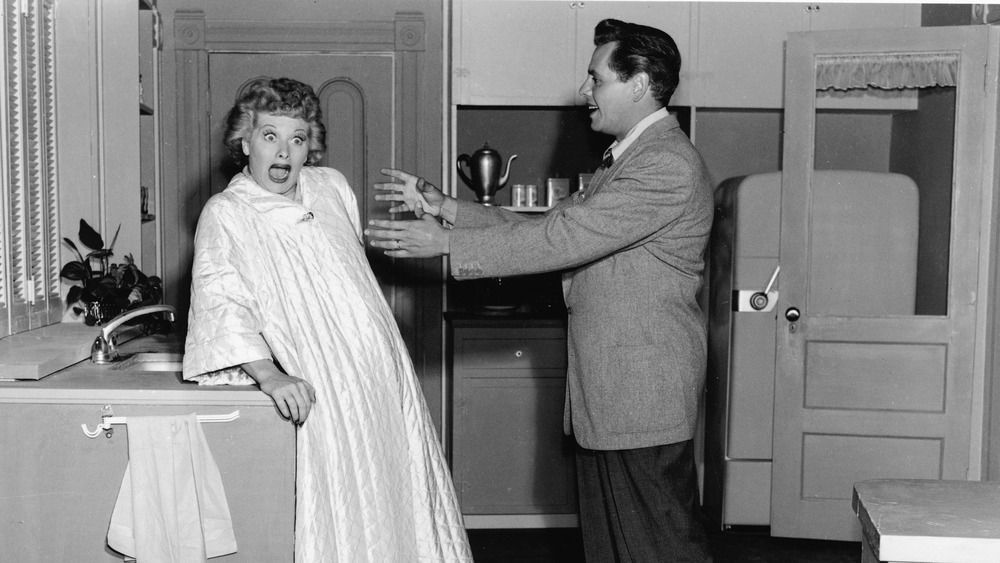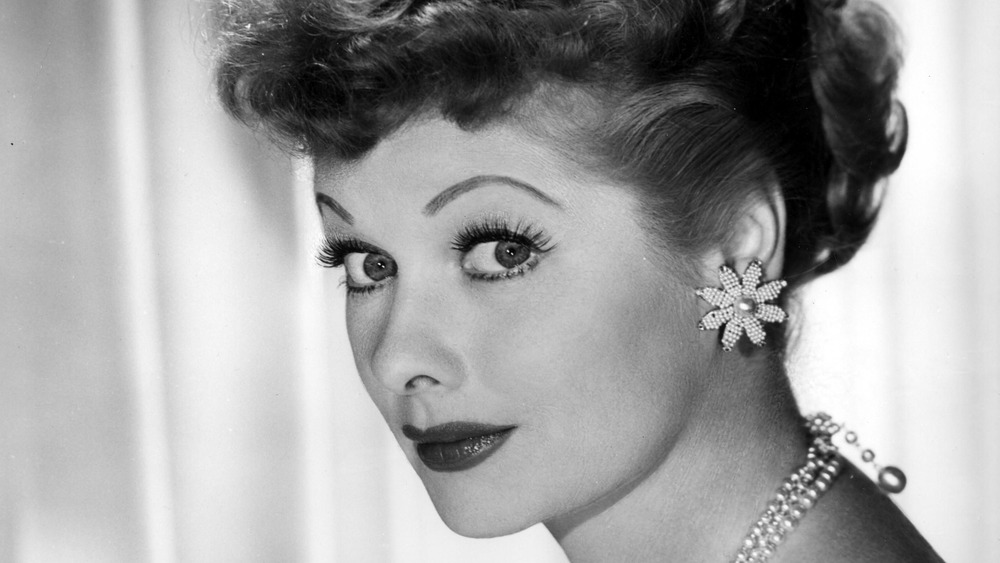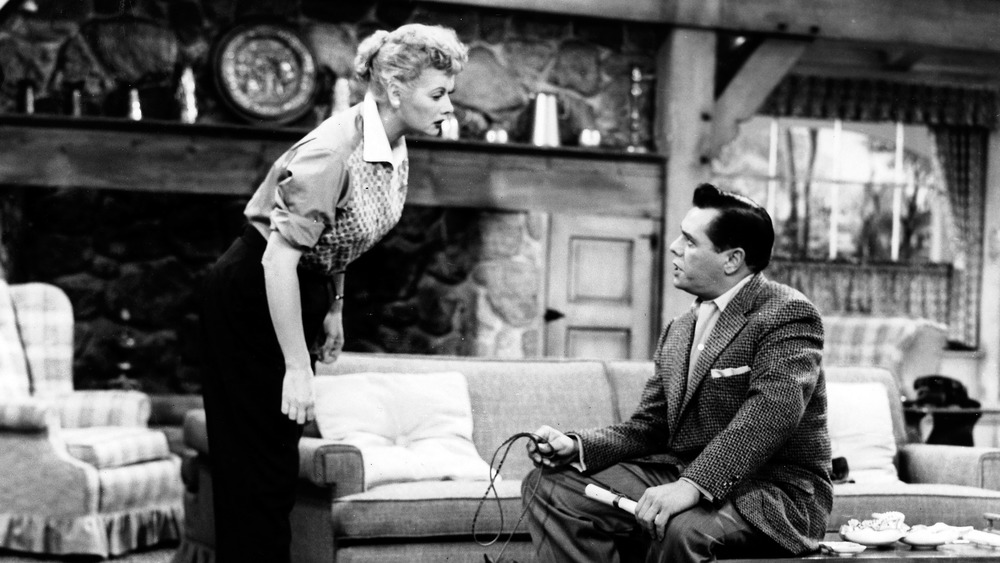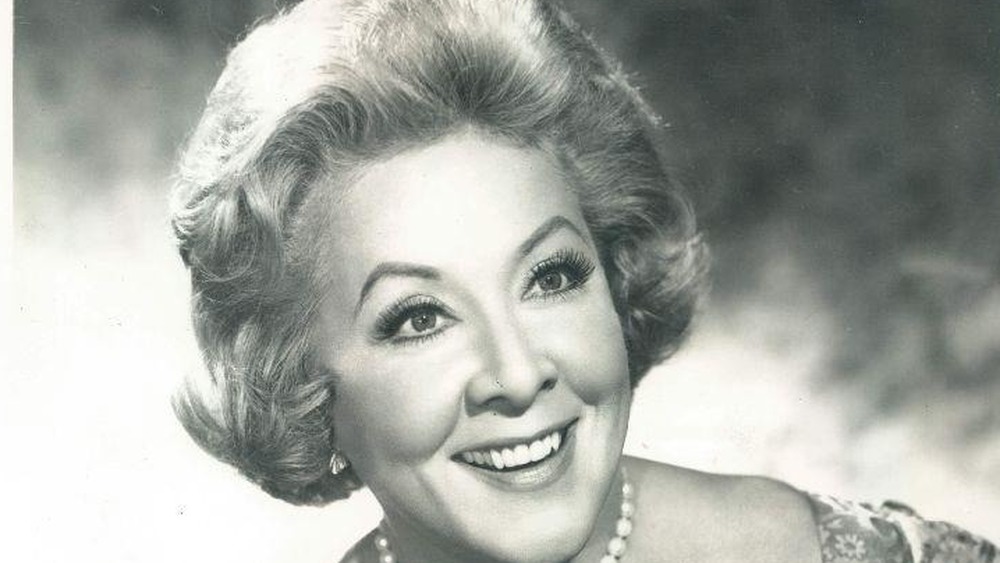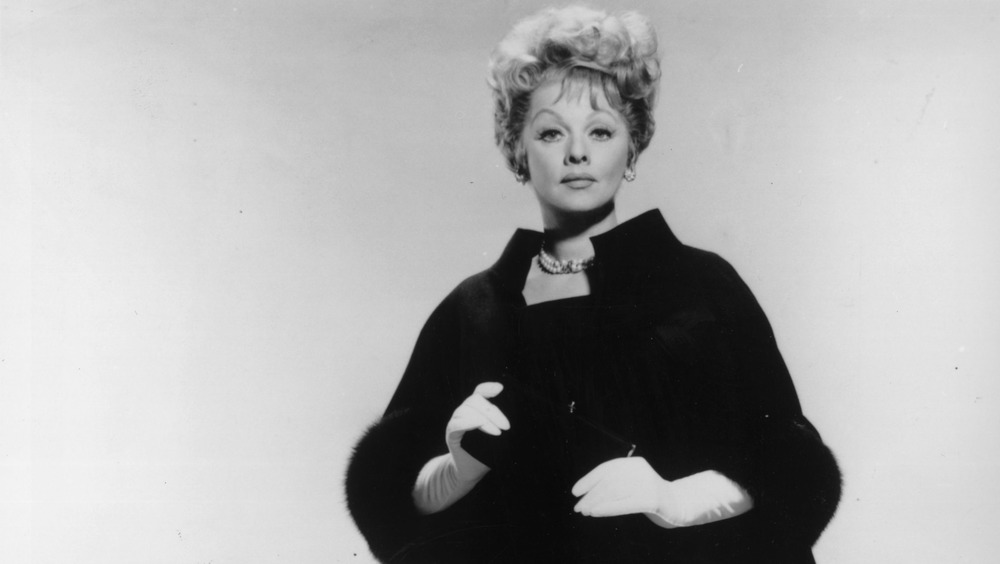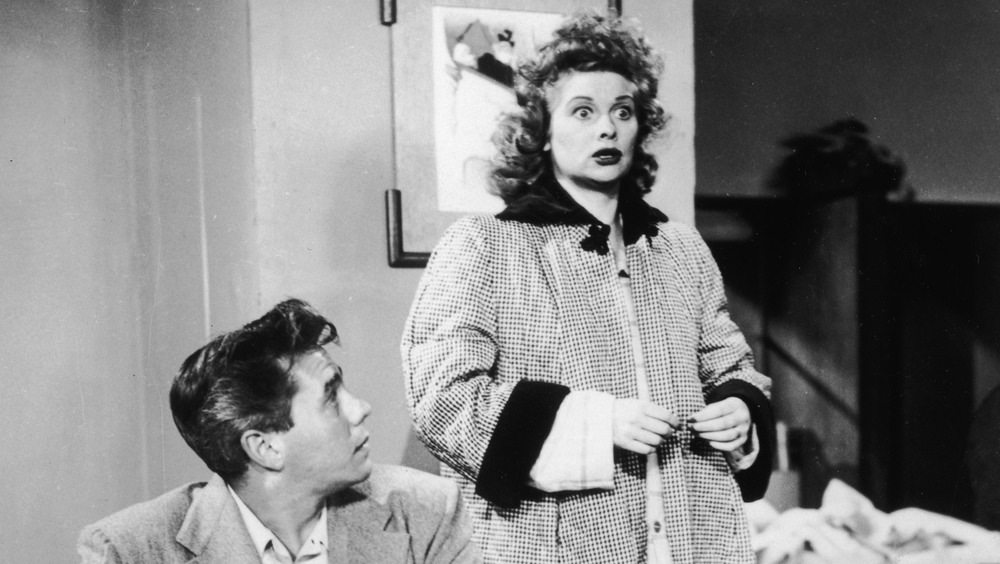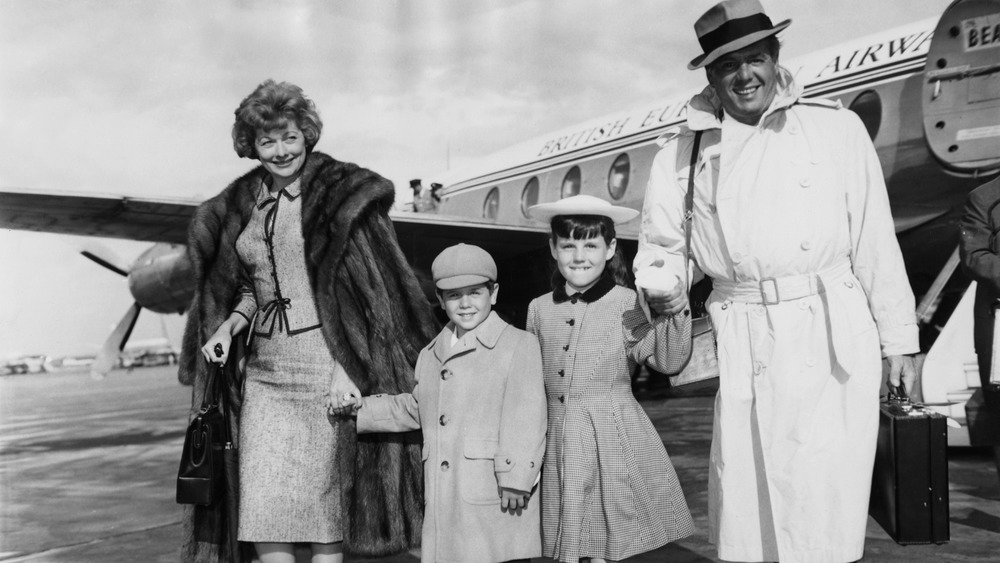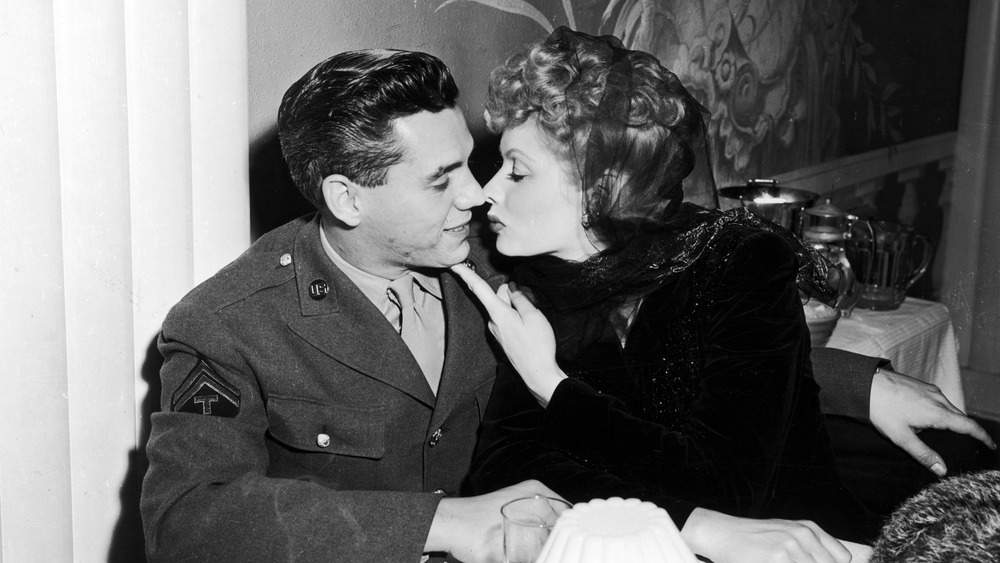The Untold Truth Of I Love Lucy
At the dawn of the post-war era, when owning a television had just become commonplace, and the idea of the ideal housewife was paramount, I Love Lucy premiered. It was an instant hit all over the United States — which was surprising given the groundbreaking nature of the show. It was the first program on television to feature a multiethnic family, Lucille Ball and her real-life husband Desi Arnaz, who was born in Cuba. While not technically the first to have a pregnant woman or a married couple shown sharing a bedroom, it has often been mistaken as the first because of Lucy's enormous popularity. Ball called a lot of the shots behind the scenes and eventually went on to also be the first woman to run her own production company, Desilu.
I Love Lucy ran from 1951-1957, six seasons and 180 episodes. Then they ran 13 hour-long episodes from 1957-1960, called The Lucy-Desi Comedy Hour. Why did audiences love Lucy so? According to the book, Ball on Fire, "Not since Carol Lombard had there been a glamorous woman so willing to make a fool of herself in pursuit of laughter." Lucy was the nation's first beautiful clown.
In the last episode to air in 1960, Ball kissed Arnaz for the last time, and they finalized their divorce. The couple had been married since 1940 and built the Desilu empire together. Sadly, the dreamy world of Lucy and Ricky was never the reality for Ball and Arnaz.
I Love Lucy was adapted from a radio show called My Favorite Husband
Before Lucille Ball became known to the world as Lucy Ricardo, she worked as a B-film actress in the 1940s, starring in dramas for MGM. According to Vulture, when she tired of waiting for her big break, "she decided to approach stardom from a different angle. Instead of making the American public come to her, she'd go to them via radio." Ball quit film to star in the radio series, My Favorite Husband, for CBS Studios in 1948.
My Favorite Husband followed the story of Liz Cugat and her husband, George, a man who was constantly frustrated with his eccentric wife. Sound familiar? The "I Love Lucy" Book states the radio show was, "well into its second season when the network tendered the TV offer, realizing that the new visual medium was about to blossom in a big way." Husband ended after nearly four years to be adapted into the beloved television sitcom, I Love Lucy.
Lucille Ball wanted Desi Arnaz as her co-star in order to save their marriage
Lucille Ball met Desi Arnaz in Hollywood on the film set of Too Many Girls in 1940. Before the end of the year, they eloped to Greenwich, Conn. to marry. Ball's career in film started to take off with an MGM contract, while Arnaz's petered out. According to The "I Love Lucy" Book, Arnaz "was not content to loaf at the couple's rambling San Fernando Valley home in Chatsworth and let Lucille be the breadwinner." So, Arnaz, who had a successful career as an orchestra leader before doing movies, returned to his first love and began touring the country with his band.
By 1944, Ball had filed for a divorce. According to Biography, she was tired of his "infidelities and heavy drinking." He was always out of town or out all night. Before the divorce was final, the couple made an agreement to make it work. To do that Ball believed she needed to find a way to keep Arnaz at home. When CBS offered her the opportunity to turn My Dear Husband into a series, she agreed to do it as long as it starred her husband.
CBS didn't want Desi Arnaz to play the lead
When Lucille Ball demanded Desi Arnaz be the lead in the televised version of My Dear Husband, CBS did not like the idea. Ball biographer, Kathleen Brady, told PBS that the studio said, "no one would believe that a red-blooded American girl could be married to a Cuban." Ball replied, "What do you mean nobody'll believe it? We are married!" (via The "I Love Lucy" Book).
In order to prove America would love it, Ball and Arnaz took their act on the road. They created a slapstick routine they'd do on tour with Arnaz's band. When their show opened at the Chicago Paramount Theater, Variety said, "Lucille Ball and hubby, Desi Arnaz, have come up with funny quips and terrific burlesque situations, which, if film comedienne wishes to continue, would make them one of the top vaudeville comedy teams." By the end of 1950, CBS had given in and greenlit the couple to star in My Favorite Husband, which became I Love Lucy and starred America's favorite sweethearts — Lucy and Ricky Ricardo.
I Love Lucy was a technical marvel
Now that Lucille Ball had her first demand met, having her real life husband, Desi Arnaz, star in I Love Lucy, it was time for her second — that the show be filmed in Los Angeles. The problem was, no show had ever been shot in Los Angeles. It was a technical impossibility.
Shows were broadcast from New York, then recorded on kinescopes. A kinescope was a camera that recorded live TV, so the recording could be sent to other markets throughout the country. The quality was terrible. According to the DGA, Phillip Morris, the show's sponsor, "...objected to making I Love Lucy in Los Angeles. The sponsor in particular didn't want the lucrative New York and East Coast market, accustomed to quality broadcasts, seeing their show the way the rest of the country saw other shows, on kinescopes."
So, Arnaz and Ball decided to shoot on film. That way it would always be preserved on a quality format. It's the reason you can still watch reruns of I Love Lucy to this day. But, film was expensive — more innovation was needed.
According to American Cinematographer, I Love Lucy was a "revolution" of "production methods of motion picture making in Hollywood" for turning out "22 minutes of TV program film in 60 minutes actual shooting time." This was achieved by creating the "multi-camera format." The show had adjoined sets — putting all the action in one place, with a studio audience, and shot continuously as if it were a play. They used three cameras simultaneously to record their wide, medium, and close-up shots. "The result is greater speed in the photography of scenes and better results in the final editing" (via American Cinematographer).
Lucille Ball and Desi Arnaz create Desilu
Even with the technical innovations created to shoot I Love Lucy as efficiently as possible, the production was going to cost $5,000 more than "the original contract called for" (via The "I Love Lucy" Book). According to Entrepreneur, "Arnaz and Ball formed Desilu Productions (the very first independent television production company) and used $5,000 of their own money to produce the pilot for "'I Love Lucy.'" They did this on the condition that they would own 100% of the show (via The "I Love Lucy" Book).
This was a genius move. Ball and Arnaz owned the show, meaning if it was successful they would make a lot more money than their weekly salary as actors. It also meant they would get residuals or profits made off of the show's reruns. How many times have you seen an I Love Lucy rerun? Cha-ching!
I Love Lucy became a hit show, so, according to Entrepreneur, Arnaz "expanded the Desilu empire, producing an impressive roster of hits, including 'The Ann Sothern Show,' 'The Untouchables' and 'Sheriff of Cochise.'" In order to further grow the business, Desilu sold their syndication rights back to CBS for $5 million. They would no longer receive money off of reruns, but they had enough money to buy RKO Studios in 1957. "The 14-acre movie lot soon became home to such hits as 'The Dick Van Dyke Show,' 'The Andy Griffith Show' and 'My Three Sons,' making Desilu a successful independent production house," according to Entrepreneur.
No character could say pregnant on I Love Lucy
During the second season of I Love Lucy, Lucille Ball became pregnant with the couple's second child, Desi Arnaz, Jr. Desi Arnaz, Sr., wanted to work this into the storyline of the show. But according to The Other Side of Ethel Mertz: The Life Story of Vivian Vance, "Phillip Morris and CBS strongly opposed the idea. In 1952, pregnant women did not readily parade on television..." Eventually CBS and Phillip Morris conceded. By that time I Love Lucy was the number-one-rated show on television, and Ball and Arnaz, Sr., were never the type to back down from a bid.
They were allowed to show Ball being pregnant and talk about her pregnancy but were never allowed to use the word "pregnant." The episode is called "Lucy is Enceinte" — "enceinte" being French for pregnant. This censorship actually assisted in making the episode fun. Lucy tries to tell Ricky she's in the family way but is continually blocked and distracted until finally she interrupts Ricky during a performance with his band. Ricky then begins singing, "We're Having a Baby."
According to The A.V. Club, "Looking at the viewership numbers garnered by Ball's onscreen pregnancy, it appears Lucy's condition was only a moral concern in the eyes of squirrelly executives; audiences clearly loved it..." This arc spanned seven episodes, ending on the finale, "Lucy Goes to the Hospital," which was a huge event with 44 million viewers. Oddly enough, the following episode was called "Pregnant Women are Unpredictable," which was "apparently okay because the episode titles never showed on screen," says The A.V. Club.
I Love Lucy owed a lot to Mary Kay and Johnny
I Love Lucy is often credited for a lot of firsts, and rightfully so, but many of their supposed "firsts" belong to another TV show featuring a married couple – Mary Kay and Johnny, the first television sitcom to ever be broadcast. The show was done live and not recorded on kinescope until later. According to Snopes, "... not even kinescopes of Mary Kay and Johnny have survived, so it exists only in the memories of those who saw the program during its original run half a century ago." This is why many assume I Love Lucy, which has stood the test of time, is the first to show the intimate details of a married couple's life on television.
According to Bustle, "Though I Love Lucy is widely quoted as the first TV series to break the chastity divide and show a married couple in bed together, that honor actually goes to Mary Kay and Johnny." Not only does Mary Kay and Johnny show them in the bedroom but in the same bed — not the twin beds the Ricardos supposedly slept in. Snopes speculates on the "lack of squeamishness" on Mary Kay and Johnny, which aired in 1947 — "Perhaps the medium was just too new for anyone to have grown uptight about such concerns yet."
Like Lucy and Ricky Ricardo, Mary Kay and Johnny Stearns were a married couple in real life. Also alike, according to Vulture, Mary Kay and Johnny "had to write Mary Kay's real pregnancy into the series, and their actual infant son appeared on the show." They also had a very special episode where Mary Kay gave birth at the hospital, which like Lucy, coincided with the birth of their actual child upon the airing of the show.
Ethel and Lucy revolutionized female friendship on TV
The Ricardo's relationship was not the only one drawing viewers into the show. The partnership between characters Ethel Mertz and Lucy Ricardo was just as fraught with humor and conflict. According to Screen Rant, "They cook up schemes together, support each other when they're in trouble, and they're forever joined at the hip. We all want a friendship like Lucy and Ethel's."
In an interview with PBS, Kathleen Brady, a Lucille Ball biographer, agrees that the friendship between Ethel and Lucy was the show's "most enduring influence." She said it was because it "celebrated the fun and the depth of female friendship." Their relationship is what inspired a long legacy of TV shows where female friendship is one of, if not the most important theme —shows like Laverne and Shirley, Sex and the City, and Broad City highlight strong female friendships. Girlfriends most likely have Ethel and Lucy to thank for Galentine's Day. Because of the dynamic of their friendship, according to HuffPost, I Love Lucy "passed the Bechdel Test before it even existed."
Lucy broke traditions with what was expected of the 50s housewife
The epitome of the 50s housewife is that of the skilled homemaker — someone who keeps a spotless home, has children that are dressed well and behaved, dotes on her husband's every desire, bakes the perfect soufflé, and does it all in an ironed dress and flawless heels. The entire comedic premise of I Love Lucy was that when it comes to being the perfect housewife, Lucy Ricardo was the worst. Kathleen Brady spoke about it with PBS, saying, "... the underlying theme of that show is the eternal power struggle between the trickster and the powers-that-be. Lucy Ricardo was one of the first female tricksters."
While some may argue Lucy Ricardo's focus on domesticity and the fact her husband was always trying to control her makes the show less progressive, for the time, I Love Lucy was a trailblazer. According to The Norton Arts Center, "Lucy always desired to be more than a housewife, and in episode after episode, she rebelled against the constraints of her role — taking a job, scheming to make money, disguising herself to perform at the club, and generally messing with Ricky. The plots directly exposed the absurdity of the restrictions placed on women in the 1950s." And she did it all before Betty Friedan's The Feminine Mystique was conceived.
Lucy Does a TV Commercial or the Vitameatavegamin episode
In the well-known and well-loved episode, "Lucy Does a TV Commercial," Lucy Ricardo wants to prove to her Ricky Ricardo that she is good actress, but he won't give her a chance. She sneaks onto a commercial set, dismisses the woman who was hired, and takes over her job. Of course it's immediately funny when she has to pronounce the name of the product, "Vitameatavegamin" — which would be hard to say even if you came prepared. As she pitches the "health tonic" to viewers, she takes sips of it, not realizing one of the main ingredients is grain alcohol. The laughs grow exponentially as she gets more and more inebriated but remains determined to show Ricky she's good at commercials.
According to Ball on Fire, during the episode "... even Desi had to chew the inside of his cheeks to keep from laughing..." Lucille Ball's talent was undeniable, and yet Desi Arnaz was jealous. Jess Oppenheimer, head writer for the show, is quoted in Ball of Fire as saying, "Desi wasn't happy in a relationship where his wife had a more powerful reputation than he did." Ball got all the credit for the show, but she was also far more experienced than Arnaz. Ball of Fire explains, "... all the timing she picked up from her stage work, all the tricks she had learned from the film farces and dramas, from radio shows, from Damon Runyon, Buster Keaton, and Jack Benny, were used to forge the character of Lucy Ricardo."
Adventures in hiring non-actors for Job Switching
While the official title of the episode is "Job Switching," many folks may remember it as "The Candy Episode" — the one where Lucy Ricardo and Ethel Mertz get jobs working at a candy factory. In an effort to keep up with a conveyor belt carrying chocolates, Lucy begins stuffing them in her mouth.
According to the book, Ball on Fire, Desi Arnaz found a real-life candy dipper at the "farmer's market on Fairfax Avenue" to play the guest star in the episode. The woman, Amanda Milligan, plays another factory employee who works alongside Lucy and Ethel. "He thought the professional's deadpan movements would make her an ideal straight man for Lucy's antics."
When it was time to film the episode, Lucy got nervous. She said, "We explained the scene to her a couple of times, and she thought we were all crazy. She never cracked a smile once. We began to think, 'Is this funny or isn't it?'" In the scene Milligan is supposed to hit Lucille Ball, but in rehearsals she'd merely "tap" her. When they finally shot the scene, Ball remembers, "Well, it came time for me to hit her, which I did, and then for her to hit me, which she did! Bam! She gave me such a shot. I thought she had broken my nose." After, Ball confronted her, and Milligan replied, "That's what you wanted, wasn't it?"
Lucy gets into a real fight in the the Grape Stomping Episode
The "Grape Stomping" episode is actually called "Lucy's Italian Movie." In it, an Italian director wants Lucy to play the role of an American tourist, but she thinks she's supposed to be a grape stomper. Grape stomping was an outdated and unnecessary practice since vineyards now had machines to squish their grapes. According to Ball on Fire, "Desi managed to find one of the last remaining grape stompers." He hired her, a woman named Teresa, to play Lucy's counterpart. Again using another non-actor proved to be an interesting experience on set.
Teresa didn't speak English and needed a translator to tell her what to do. Lucille Ball recalls, "The time came for us to get in the vat, which was full of real grapes." She goes on to say, "We started stomping grapes, and I made a dance out of it, and then I slipped." She accidentally hit Teresa, who in turn, hit her back. Ball says, "She just held me down, hitting me. I thought she was trying to kill me. I had grapes up my nose, up my ears. She was choking me." No one knew Ball was struggling, as they thought it was all a part of the show. And that Ball would do anything for a laugh.
Ricky never says, Lucy, you got some 'splaining to do
All the most memorable TV shows have famous catchphrases. Friends — "How YOU doin'?" Good Times — "Dyn-O-Mite." The Brady Bunch — "Marcia, Marcia, Marcia!" And for I Love Lucy, it's Ricky Ricardo saying, "Lucy, you got some 'splaining to do." Except, Ricky never says that line. He may say, "'splain" a lot, but he has never once said that line specifically. According to Complex, "It's widely thought that a journalist must have misattributed the quote toward the end of the series run, and from that point forward, the catchphrase that wasn't was forever committed to history."
While viewers may have enjoyed poking fun at Ricky's accent when quoting him, they didn't want any of the characters but Lucy to do it on the show. In Ball on Fire, author Stefan Kanfer explains, "In the beginning, Ricky's botched pronunciations were mocked by other members of the troupe, but the jokes went over poorly with audiences. Soon, only Lucy was allowed to make fun of her husband because the mockery was done with affection..."
Fred and Ethel Mertz hated each other on and off screen
Fred and Ethel Mertz were unabashedly angry and displeased with each other on screen, and that's why audiences loved them. But the actors, Vivian Vance and William Frawley, hated each other in real life too. Vance came from Broadway and thought she was better than Frawley, who came from Broadway as well but spent the majority of his career as a character actor starring in over a hundred films. According to The Other Side of Ethel Mertz: The Life Story of Vivian Vance, Vance said, "How can anyone believe that I'd be married to that old coot..." What Frawley said in response is not safe for prime-time television. Frawley had a bad reputation for drinking and being unprofessional, but he was a great actor, so they kept him around.
Hedda Hopper, the scariest gossip columnist in Hollywood, was friends with Lucille Ball and was able to keep any unfavorable press about the I Love Lucy cast out of print. According to The Other Side of Ethel Mertz: The Life Story of Vivian Vance, the studio instead wrote press releases that said things like, "Vivian, Bill and the Arnazes have a four-way admiration society." And they'd quote Vance saying, "Bill is a darling." No one knew for years about the constant bickering behind the scenes.
Lucille Ball was accused of being a communist
Coming off a successful first season of I Love Lucy, in the spring of 1952, Lucille Ball discovered she was being investigated by the House Committee of Un-American Activities (HUAC). In 1936, Ball had registered as a Communist. According to Ball on Fire, "In 1947, the Hollywood Ten, a group of screenwriters and one-time members of the Communist Party, had been blacklisted out of the business. At the urging of the HUAC, studios initiated a campaign to rid themselves of all those with a radical past."
Ball was summoned to testify before Congress. According to the The New York Times, "Ball explained that she had done it to humor her eccentric Socialist grandfather — Ball's mother had also registered as a Communist, for the same reason — and that she hadn't actually voted in the election." The HUAC accepted this history, and let Lucille Ball go. "The charges prompted Desi Arnaz to quip, 'The only thing red about this girl is her hair and even that we're not so sure about.'"
I Love Lucy continued airing and gaining in popularity, but the investigation was never quite over. According to the The Washington Post, "The committee forgave her, but J. Edgar Hoover never forgot. The FBI director continued to collect evidence about Ball..." There were FBI files on Arnaz's as late as 1959. "Hoover was notorious for collecting ammunition against his enemies to use for future face-offs, and a face-off with Arnaz was a distinct possibility."
The original pilot for I Love Lucy was not seen until 1990
In 1989, CBS unearthed an old I Love Lucy Christmas special and aired it. The ratings were terrific, prompting a search for other missing episodes. In 1951, Desi Arnaz and Lucille Ball shot their own pilot in a studio in New York, but it never aired. It was recorded on a kinescope. According to a 1990 article in The Washington Post, "Arnaz apparently had given a print of the episode to Pepito, a clown who's featured in the show. Pepito's widow discovered it and gave it to B. Donald (Bud) Grant, the former CBS Entertainment president who now runs Grant/Tribune Productions, and is producing the special that includes it."
CBS aired the special on April 30 1990. According to AP News, "By a CBS estimate, 40 million viewers saw, 'I Love Lucy: The Very First Show,' a Monday special featuring the 34-minute pilot, which Lucille Ball and Desi Arnaz filmed in black and white at their own expense on March 10, 1951." It was hosted by Lucie Arnaz, Ball and Arnaz's first child, whom Ball was pregnant with in that very first episode.
The first pilot never aired because the show was drastically changed after landing Phillip Morris as a sponsor. The initial pilot had Arnaz's agent as a main character, which was later cut because it, "would skew the program away from the couple and toward Desi," writes Stefan Kanfer in Ball on Fire. They made Lucy and Desi Ricardo more working class and relatable, and added Fred and Ethel Mertz as their neighbors to make the version of I Love Lucy that known today.
Lucille Ball and Desi Arnaz were not Ricky and Lucy
In many ways I Love Lucy was an example of art imitating life — in real life Lucille Ball and Desi Arnaz were married, Arnaz was a band leader, and they had a baby the same day Lucy and Ricky Ricardo had a baby. But behind the scenes, the marriage between Ball and Arnaz was tumultuous. According to Ball on Fire, "With all of the efforts to create a nuclear family, Lucy spent much of the week alone with the baby, while Desi went to his thirty-eight-foot power cruiser Desilu and joined the roistering buddies who had been banished from the ranch."
Jerry Hausner, who played Ricky's agent in the pilot, talked about Arnaz to the The Washington Post, saying, "He screamed at me and called me names in front of the audience. He was drunk a lot of the time... I went to the producer and said, 'Write me out of this thing.'" Ball had hoped the show would bring their family together, but Arnaz continued to party and engage in affairs.
According to Vanity Fair, a tabloid magazine called Confidential ran a story about Arnaz and Ball. "The cover of the January 1955 issue featured a shot of Lucille hugging Desi above the words: 'Does Desi Really Love Lucy?'" The article goes on to quote Arnaz reportedly telling a friend, "What's she upset about? I don't take out other broads. I just take out hookers."
Lucille Ball would have loved to have been Lucy
In 1960, when the stress of the show and their marriage had been enough, Lucille Ball filed for a divorce from Desi Arnaz. Arnaz and Ball shared their last kiss on the last episode of The Lucy-Desi Comedy Hour. Ball went on to run Desilu, helping produce shows like The Untouchables and Star Trek. While Ball has received a lot of fanfare for being a "girlboss," her biggest dream was to be a housewife.
According to PBS, "Lucille herself did not want to be seen as a lady executive... In her first interview as the head of Desilu Studios, she dusted her office as she talked about the company's plans for the future." It seemed throughout all her success, all she ever wanted was Arnaz and for their family to be together. When her film career was failing and she was deciding what to do next, before signing on to do My Dear Husband, she said, "Of all the thirty or forty films I had made up to that time, I could find only find three or four scenes in those pictures that I cared anything about... I discovered they were domestic scenes where I portrayed a housewife," as per The "I Love Lucy" Book.

